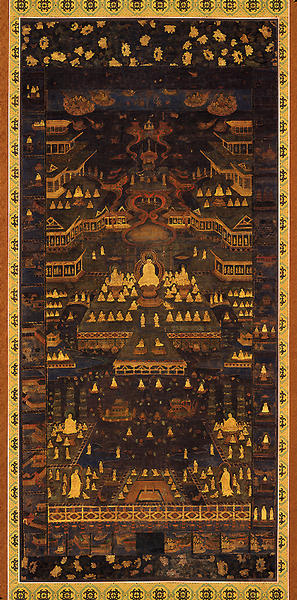浄土曼荼羅図
- 鎌倉時代
- 14c
- 絹本著色
- H-89.8 W-41.3
鎌倉時代 14世紀
絹本著色
縦:89.8cm 横:41.3cm
諸仏の浄土を描いたものを一般に浄土曼荼羅というが,本作品は中央部に阿弥陀如来のいる西方極楽浄土のありさまを表し,その周辺に韋提希夫人の物語(向かって左辺),極楽を想い浮かべるための十三観(右辺),極楽に往生するさまである九品往生(下辺)を図示したものである。『観無量寿経』およびその注釈書である善導撰『観経 四帖疏』に基づくところから,観経変相図といわれる。ただ,日本ではその図様の原本が奈良・当麻寺にあることにちなみ,当麻曼荼羅と呼ぶことが多い。
この図様が一般に流布するようになったのは,浄土宗西山派の証空が嘉禎3年(1237)に当麻寺の原本を転写し,また縮写本数種を作って,日本国中に広めるようになってからとみなされる。証空の転写のときには,すでに九品往生の場面や下辺中央の銘文が,絹の脱落のためわかりにくくなっていたようだ。往生の場面で,原本は来迎の群衆は坐像であったとみなされるのに対し,証空系の図様では当時の流行であった立像に変えられている。
本作品はその当麻曼荼羅の一例であるが,極端に縦長画面となっている点が珍しい。しかし,中央部下端の父子相迎会(阿弥陀を父,衆生を子にたとえ,極楽に往生した衆生が阿弥陀と対面する場面をいう)も含め,大事な箇所が省かれるようなことはない。上下の蓮華唐草文による描表装も当初からのものとみなされる。諸尊は金泥身に朱線で描き起こされ,着衣は丹地に卍繋ぎ文や麻葉文,篭目文ほかの截金文様で飾られている。可憐な表情が印象的で,鎌倉時代後半にさかのぼる制作とみられる。(泉)
初期大乗仏教における仏教の世界観の発展
初期大乗仏教における仏教の世界観の発展
インドの大乗仏教はおおまかに初期、中期、後期に大別できますが、紀元前後から300年頃までの初期大乗仏教は仏教の信仰実践を中心として、釈迦の精神をもっとも良く発揮しているといわれており、「般若心経」などの般若系教典、「法華経」「維摩経」「無量壽経」「華厳経」などがこの期に属する教典として知られています。これらの教典に見られる仏教世界観の発展の様を通観してみましょう。
がんらい仏教では一世界には仏陀は一時に一人しか現われないとされていました。しかし、原始仏教の時代にも釈迦が悟りを開く以前、過去に六人の仏陀が現われ、人々を教化救済したとする考えがありました。また釈迦入滅後にも、未来の仏として弥勒仏が出現するとも考えられていました。部派仏教の時代になると、これが発展し過去・現在・未来の三世にわたって多くの仏陀が出現して法を説いているとする考えが生まれ、部派のひとつの大衆部の一派では、釈迦仏が法を説いたこの世界(娑婆世界)のほかに十方に種々の世界があって、それぞれの世界に同時に仏陀が現れて法を説くと考えるようになりました。
大乗仏教ではこの考えをさらに発展させ、三世十方の世界には無数の仏陀が出現すると説くようになりました。釈迦が法を説くこの世界は一仏世界であり、須弥山(しゅみせん)を中心として、この頂に三十三天、四周の麓に四天王のいる四王天がある。その東に勝身州(弗婆堤)、南に 部州(閻浮堤)、西に牛貨州(倶耶尼)、北に倶 州(くるしゅう)という人の住む大陸があり、周辺を鉄囲山(てっちせん)が囲んでいる。四州の地下には地獄があると考えられています。このような世界観は次第に拡大し、このような世界を小千世界として、これを千あわせたものを中千世界、そしてこの中千世界を千あわせた世界を三千大千世界と言うようになりました。
「梵網経」で説かれる蓮華胎蔵世界は、このような世界観を現わしたもので、三千大千世界の教主であるル舎那仏が坐る千葉の蓮華の一枚一枚に、さらに釈迦仏が坐る千葉の蓮華があり、この葉のそれぞれに一人一人の小釈迦が主宰する小千世界が存在すると考えられています。このような世界観は我が国にも伝えられ、奈良東大寺の大仏はこのような世界を現わしています
阿弥陀三尊来迎図
阿弥陀来迎図
阿弥陀仏図
阿弥陀如来懸仏
阿弥陀如来坐像
Catalogue Entry
Kamakura period, 14th century
Hanging scroll, color on silk
Height, 89.8cm; width, 41.3cm
Mandala images depicting the pure land paradises of the various Buddhas are, in general, called Pure Land Mandalas. Here, however, the central section depicts the Pure Land Paradise of the West of Amida Nyorai (Amitabha), while the tale of Idaike (Vaidehi) (to the left from the viewer's position), the 13 aspects to evoke thoughts of Paradise (right), and the kubon-ojo categories of the people who attain rebirth in Paradise (lower section) are shown around this central Paradise scene. The Kanmuryoju sutra (Amitayur-buddha-dhyana-sutra) and its commentary, Sha∀n Dao's (Zen Do) Kangyo Shijo-no-sho, form the basis for this set of images, and this iconography is called a "Kangyo Henso" image. The Taima Mandala is the iconographic basis for this subject in Japan, and as a result these images are frequently called Taima Mandalas.
This iconography is thought to have been generally disseminated when Shoku of the Seizanha branch of the Jodo sect copied the original image in Taimadera, Nara, in 1237 (Katei 3), and when a number of reduced-size versions of the image were made. These images were then spread throughout Japan. By the time Shoku made his copy, the kubon-ojo scene and the inscription in the center of the lower edge had already become hard to decipher due to ground silk losses. It is thought that originally a raigo group of figures arranged in seated positions was part of the ojo section, but in the Shoku lineage iconography, these figures have been changed to the standing forms of the deities, the popular style at the time.
The present work is an example of these Shoku lineage Taima Mandalas. Its extremely tall and narrow format is unusual in this group, and yet none of the important scenes from the original image have been omitted, including the Fushi- sogoe scene at the bottom edge of the central section (Amida is depicted as the father, the masses as the children, and the masses who have been reborn in Paradise face Amida). The painted mount of lotus and karakusa motifs at the top and bottom of the silk are also considered to be part of the original image. The various deities have bodies painted in gold paint with details picked out in cinnabar red lines. The drapery is shown with tan red grounds, and cut gold leaf motifs are used to decorate the draperies, including linked swastika motifs, hemp leaf motifs, and basket weave motifs. The sweet expressions of the deities are particularly impressive, and the work can be considered to have been painted in the latter half of the Kamakura period. TI
